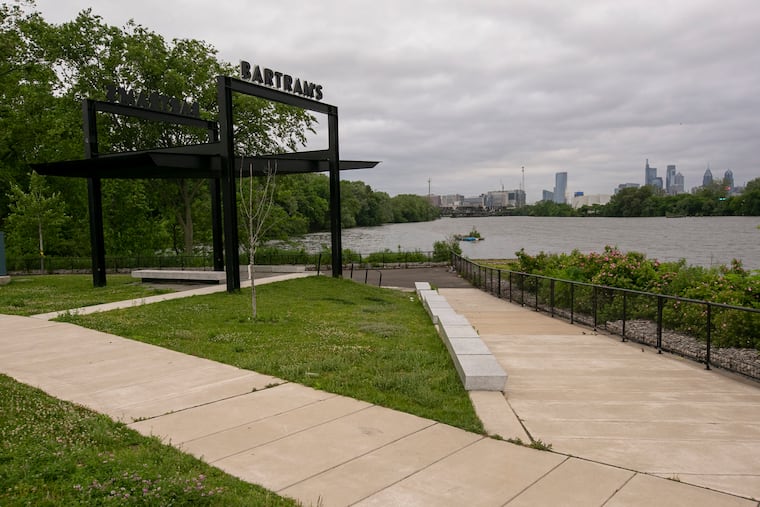$25M in conservation grants and other funds announced for Delaware River projects, including a water trail
The money will fund 41 projects along the watershed in Pennsylvania, New Jersey, and Delaware. The grants are designed to enhance recreation, water quality, and habitat conservation.

The National Fish and Wildlife Foundation and the U.S. Fish and Wildlife Service announced $11.5 million in grants Monday toward Delaware River watershed conservation that will include development of a water trail in Camden, restoration of a shad passage on the Brandywine River, and building a riverfront education center at historic Bartram’s Garden in Philadelphia.
The sum was matched by $13.5 million from environmental and conservation nonprofits that partner with the two federal agencies, bringing the total to $25 million.
The money will fund 41 projects along or near tributaries of the watershed in Pennsylvania, New Jersey, and Delaware. The grants are designed to enhance recreation, water quality, and habitat conservation.
“These 41 projects announced today will help ensure a healthier, cleaner, and more resilient future for the Delaware River watershed and the diverse species that depend on it,” said Jeff Trandahl, executive director and CEO of the National Fish and Wildlife Foundation (NFWF).
Grants to protect the watershed are awarded annually through the federally administered Delaware Watershed Conservation and Delaware River Restoration funds. Funding for conservation comes through the Delaware River Basin Conservation Act of 2016 and is administered by the U.S. Fish and Wildlife Service in partnership with the National Fish and Wildlife Foundation. Funding for restoration is provided to NFWF by the William Penn Foundation.
» READ MORE: From cargo to canoes, many ways to make a living on the Delaware River
The agencies say the new projects will improve 12,000 acres through enhanced management, treat polluted runoff using agricultural conservation practices on about 937 acres, restore 585 acres of wetlands, plant nearly 2,000 trees, and establish over 1,500 acres of new public access lands.
The projects are designed to help advance the Delaware River Watershed Initiative, an initiative largely funded by the William Penn Foundation, which has spent more than $120 million since 2013.
The Delaware River watershed covers 13,500 square miles in New York, New Jersey, Pennsylvania, and Delaware and requires large-scale coordination among states, local governments, and landowners to lessen pollution and preserve water quality, which can be impacted by sewage treatment plants, agricultural runoff, and stormwater.
» READ MORE: Is it safe to swim in the Delaware River? It's complicated
One local project calls for a 6,000-square-foot ecosystem education center to complement a production-scale hatchery for freshwater mussels at the southern border of Bartram’s Garden in Southwest Philadelphia on the Schuylkill.
The 8,500-square-foot freshwater mussel hatchery planned in conjunction with the Partnership for the Delaware Estuary will produce up to half a million mussels each year, to be seeded in local streams, wetlands, and waterways, where each adult mussel can filter up to 20 gallons of water each day, according to Caroline Winschel, director of development at Bartram’s Garden.
Winschel called the hatchery “cutting edge science,” and “a world-class facility, likely the first of its kind in the world.”
Among the other local projects:
A $750,000 federal grant and $761,000 in matching funds to Ducks Unlimited to restore 150 acres of the Henderson Marsh at John Heinz National Wildlife Refuge in Philadelphia, which will help reduce flooding in neighboring communities, and expand opportunities for kayaking and fishing.
A $123,200 federal grant and $124,000 in matching funds to New Jersey Audubon Society to restore 60 acres of habitat and a half-mile of stream to help protect the federally threatened bog turtle and other species.
A $175,000 federal grant and $220,257 in matching funds to Glenolden, Delaware County, to stabilize 550 feet of stream bank, build a riparian buffer and redirect flow from a 48-foot stormwater pipe to a wetland in Glenolden Community Park, and help prevent flooding in nearby Philadelphia.
A $151,723 federal grant and $151,723 in matching funds to the Brandywine Conservancy & Museum of Art for removal of Hoffman’s Mill dam along the Brandywine to improve aquatic habitat and restore free-flowing waters across Brandywine Creek and contribute to the return of migratory shad after a 200-year absence.
A federal grant of $220,000 and matching funds of $73,334 to Rutgers and the state of New Jersey for green stormwater infrastructure in the Upper Salem River watershed to reduce stormwater runoff pollution, such as nitrogen, phosphorus, and suspended solids.
A $500,000 federal grant and $1.5 million in matching funds to the Upstream Alliance to develop a 13-mile water trail along the Cooper River in Camden. The money will also pay for recreational programming, such as fishing and kayaking, for 2,000 residents, hiring of eight residents to run the programs, and habitat restoration for American shad and river herring.
» READ MORE: Shad, trout, invasives: What three kinds of Delaware River fish reveal about our region
Eve Quinones, an environmental educator for Camden County who grew up in Camden, said many residents are disconnected from both the Cooper and Delaware Rivers because they have been “walled off” by industry and pollution. A new river trail would help break down those walls, she said.
“My goal is that this grant gets Camden on the water, hopefully enriching thousands of peoples’ lives,” Quinones said.
Stuart Clarke, Watershed Protection Program Director at the William Penn Foundation, said the initiatives are important because, “The Delaware River Watershed is an interconnected system that needs unified efforts to ensure its health and resilience.
Trandahl said the projects “will help ensure a healthier, cleaner, and more resilient future for the Delaware River watershed and the diverse species that depend on it.”